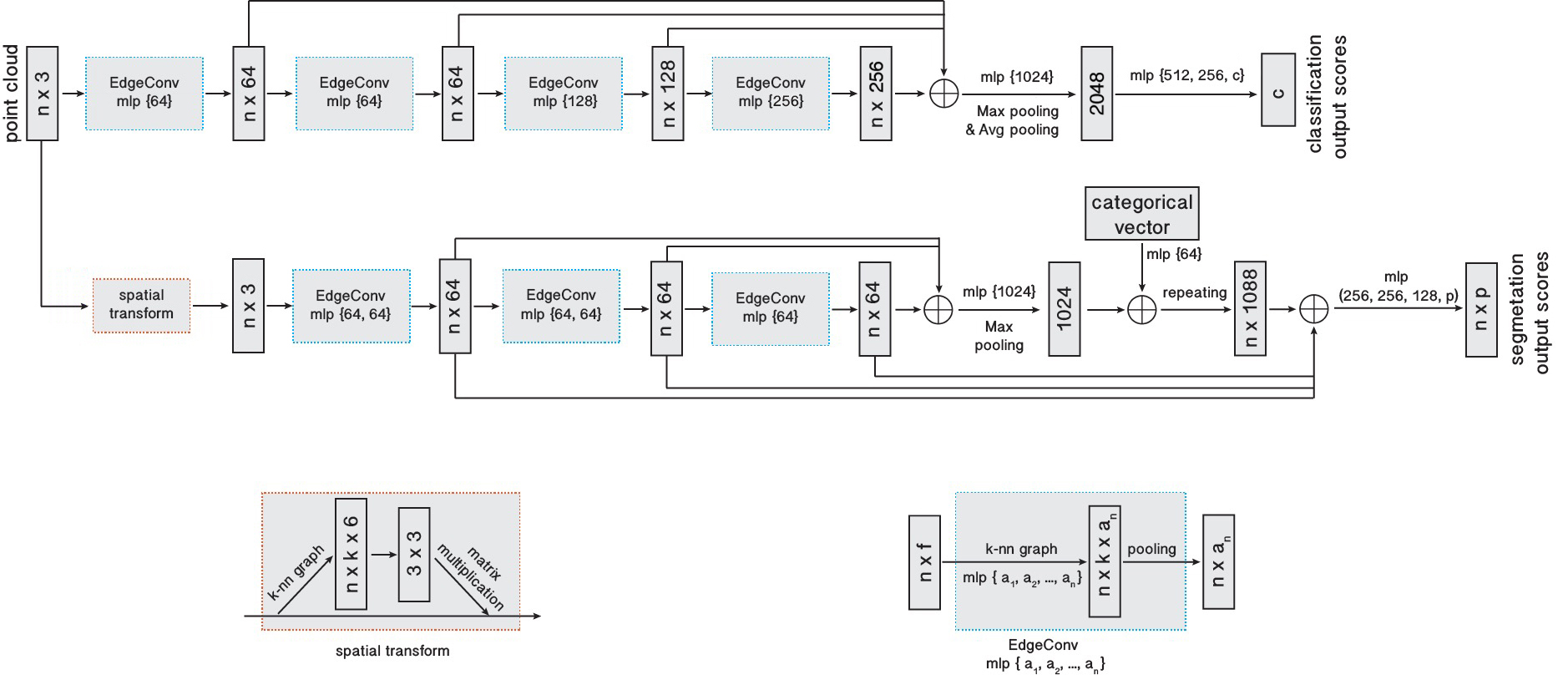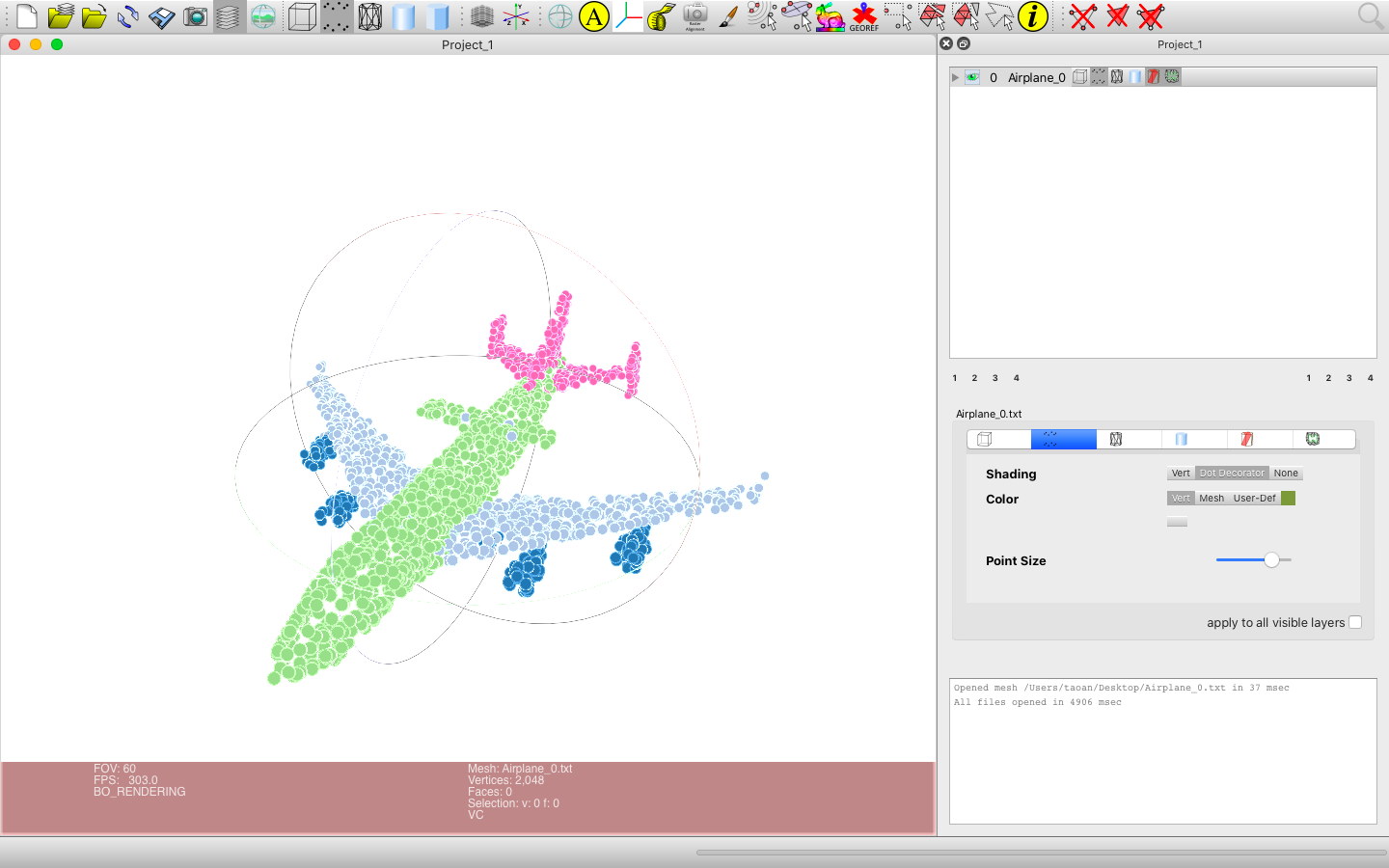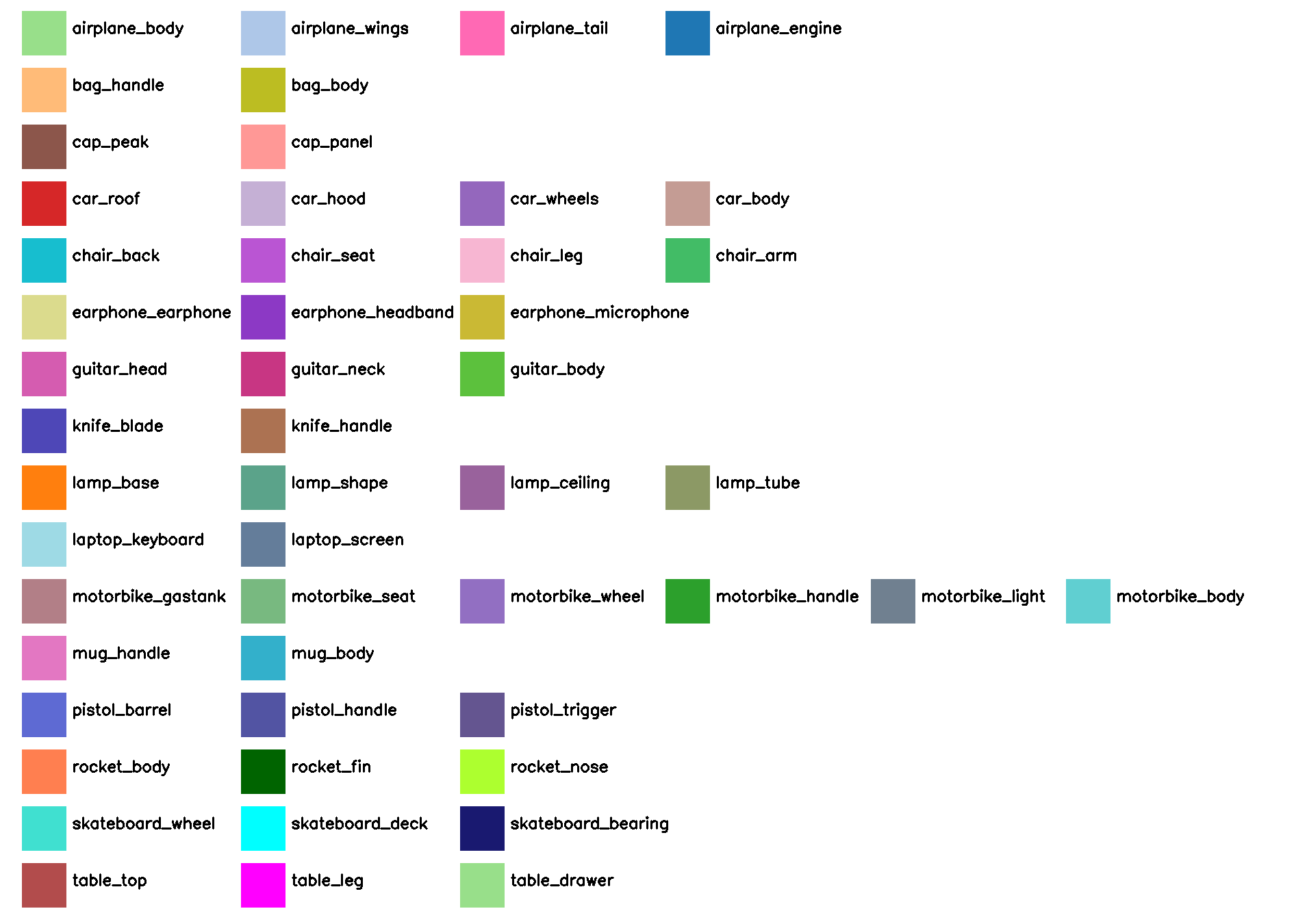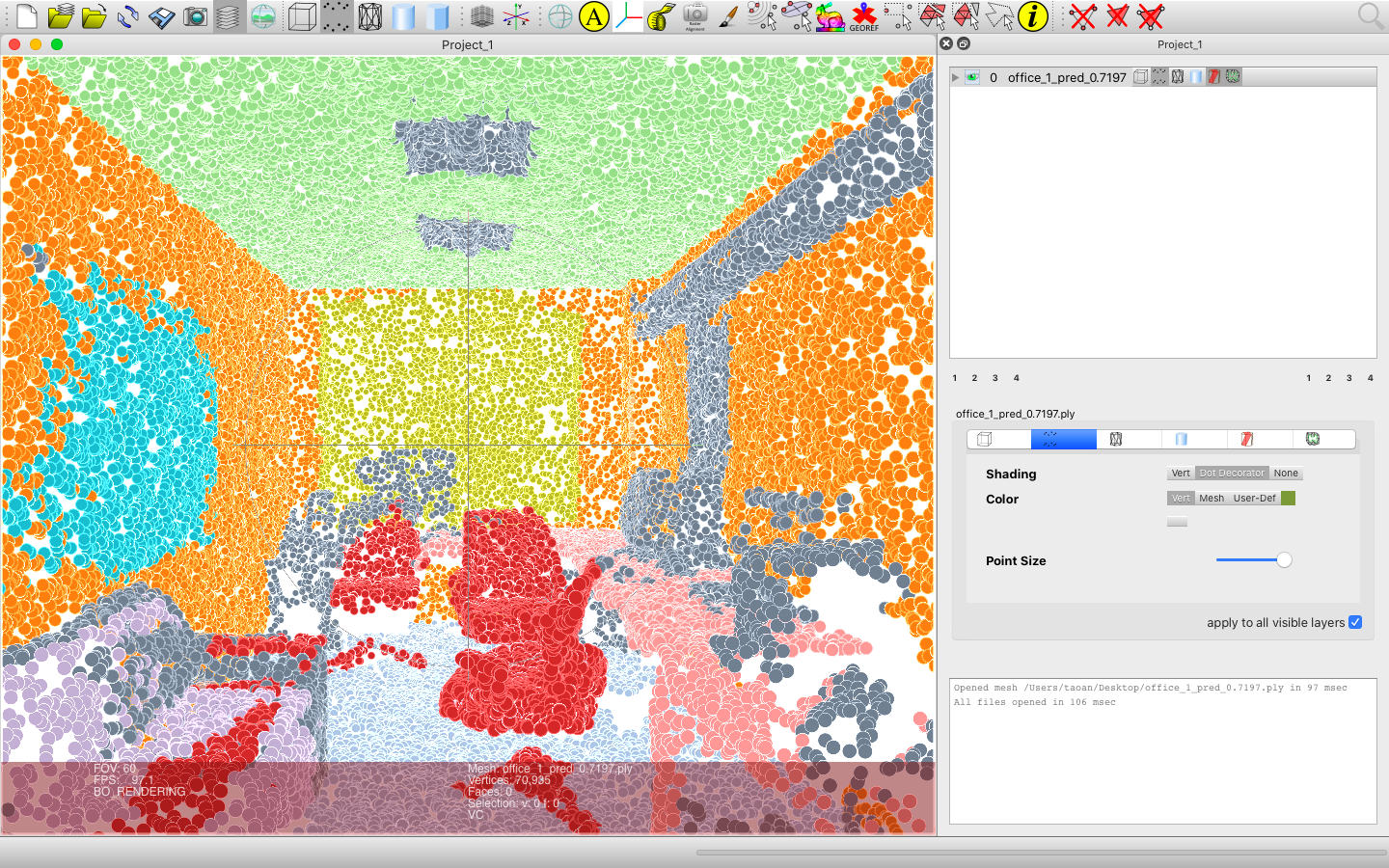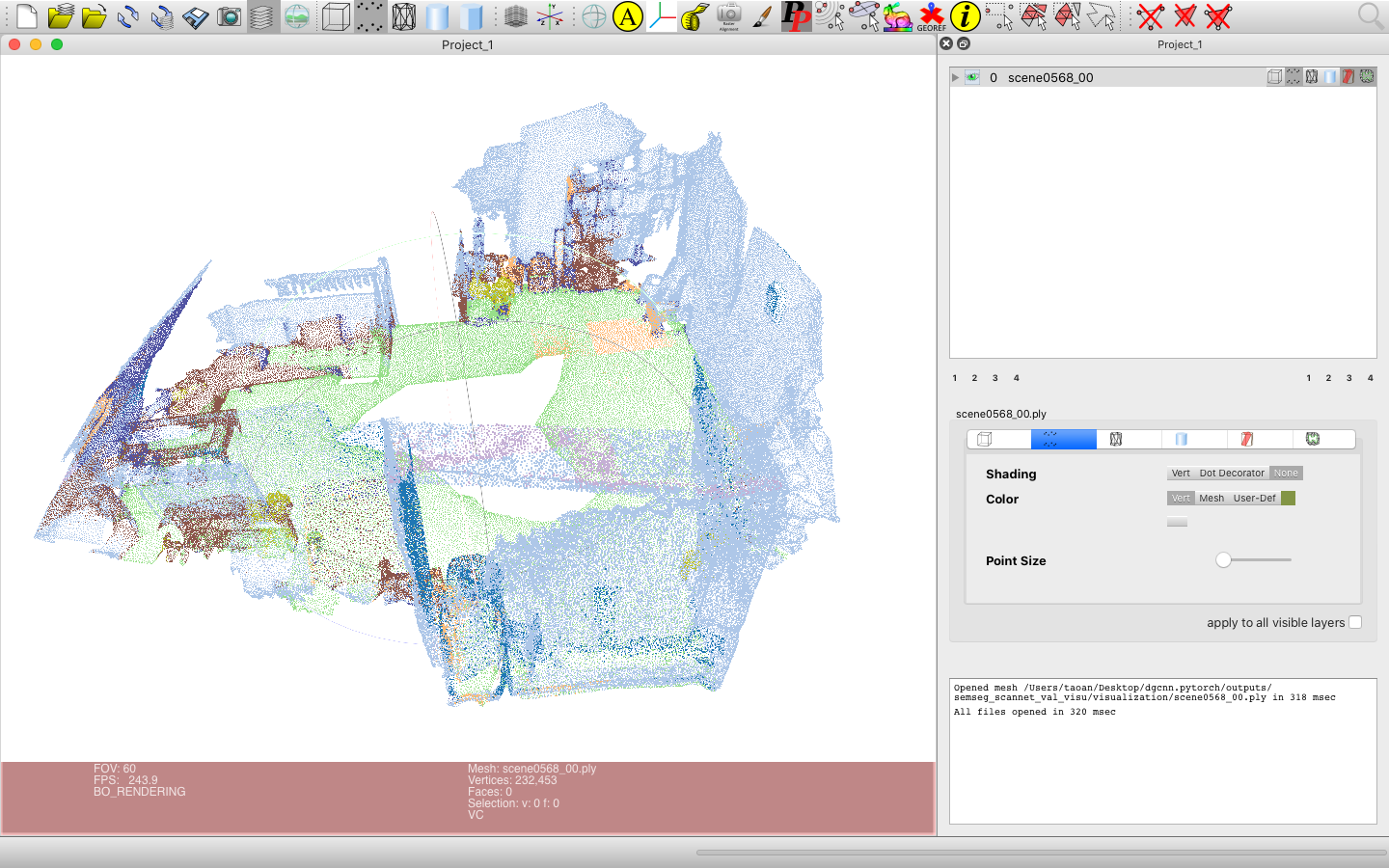This repo is a PyTorch implementation for Dynamic Graph CNN for Learning on Point Clouds (DGCNN)(https://arxiv.org/pdf/1801.07829). Our code skeleton is borrowed from WangYueFt/dgcnn.
Updates:
- [2022/10/22] Add semantic segmentation on the ScanNet dataset by Ziyi Wu (dazitu616@gmail.com) and Yingqi Wang (yingqi-w19@mails.tsinghua.edu.cn).
- [2021/07/20] Add visualization code for part segmentation and semantic segmentation by Pengliang Ji (jpl1723@buaa.edu.cn).
The network structure (Fig. 3) for classification in DGCNN paper is not consistent with the corresponding description in section 4.1 of the paper. The author of DGCNN adopts the setting of classification network in section 4.1, not Fig. 3. We fixed this mistake in Fig. 3 using PS and present the revised figure below.
Tip: The result of point cloud experiment usually faces greater randomness than 2D image. We suggest you run your experiment more than one time and select the best result.
- Python >= 3.7
- PyTorch >= 1.2
- CUDA >= 10.0
- Package: glob, h5py, sklearn, plyfile, torch_scatter
- Point Cloud Classification
- Point Cloud Part Segmentation
- Point Cloud Semantic Segmentation on the S3DIS Dataset
- Point Cloud Semantic Segmentation on the ScanNet Dataset
Note: All following commands default use all GPU cards. To specify the cards to use, add CUDA_VISIBLE_DEVICES=0,1,2,3 before each command, where the user uses 4 GPU cards with card index 0,1,2,3. You can change the card number and indexes depending on your own needs.
- 1024 points
python main_cls.py --exp_name=cls_1024 --num_points=1024 --k=20
- 2048 points
python main_cls.py --exp_name=cls_2048 --num_points=2048 --k=40
- 1024 points
python main_cls.py --exp_name=cls_1024_eval --num_points=1024 --k=20 --eval=True --model_path=outputs/cls_1024/models/model.t7
- 2048 points
python main_cls.py --exp_name=cls_2048_eval --num_points=2048 --k=40 --eval=True --model_path=outputs/cls_2048/models/model.t7
- 1024 points
python main_cls.py --exp_name=cls_1024_eval --num_points=1024 --k=20 --eval=True --model_path=pretrained/model.cls.1024.t7
- 2048 points
python main_cls.py --exp_name=cls_2048_eval --num_points=2048 --k=40 --eval=True --model_path=pretrained/model.cls.2048.t7
ModelNet40 dataset
| Mean Class Acc | Overall Acc | |
|---|---|---|
| Paper (1024 points) | 90.2 | 92.9 |
| This repo (1024 points) | 90.9 | 93.3 |
| Paper (2048 points) | 90.7 | 93.5 |
| This repo (2048 points) | 91.2 | 93.6 |
Note: The training modes 'full dataset' and 'with class choice' are different.
- In 'full dataset', the model is trained and evaluated in all 16 classes and outputs mIoU 85.2% in this repo. The prediction of points in each shape can be any part of all 16 classes.
- In 'with class choice', the model is trained and evaluated in one class, for example airplane, and outputs mIoU 84.5% for airplane in this repo. The prediction of points in each shape can only be one of the parts in this chosen class.
- Full dataset
python main_partseg.py --exp_name=partseg
- With class choice, for example airplane
python main_partseg.py --exp_name=partseg_airplane --class_choice=airplane
- Full dataset
python main_partseg.py --exp_name=partseg_eval --eval=True --model_path=outputs/partseg/models/model.t7
- With class choice, for example airplane
python main_partseg.py --exp_name=partseg_airplane_eval --class_choice=airplane --eval=True --model_path=outputs/partseg_airplane/models/model.t7
- Full dataset
python main_partseg.py --exp_name=partseg_eval --eval=True --model_path=pretrained/model.partseg.t7
- With class choice, for example airplane
python main_partseg.py --exp_name=partseg_airplane_eval --class_choice=airplane --eval=True --model_path=pretrained/model.partseg.airplane.t7
ShapeNet part dataset
| Mean IoU | Airplane | Bag | Cap | Car | Chair | Earphone | Guitar | Knife | Lamp | Laptop | Motor | Mug | Pistol | Rocket | Skateboard | Table | |
|---|---|---|---|---|---|---|---|---|---|---|---|---|---|---|---|---|---|
| Shapes | 2690 | 76 | 55 | 898 | 3758 | 69 | 787 | 392 | 1547 | 451 | 202 | 184 | 283 | 66 | 152 | 5271 | |
| Paper | 85.2 | 84.0 | 83.4 | 86.7 | 77.8 | 90.6 | 74.7 | 91.2 | 87.5 | 82.8 | 95.7 | 66.3 | 94.9 | 81.1 | 63.5 | 74.5 | 82.6 |
| This repo | 85.2 | 84.5 | 80.3 | 84.7 | 79.8 | 91.1 | 76.8 | 92.0 | 87.3 | 83.8 | 95.7 | 69.6 | 94.3 | 83.7 | 51.5 | 76.1 | 82.8 |
Use --visu to control visualization file.
- To visualize a single shape, for example the 0-th airplane (the shape index starts from 0), use
--visu=airplane_0. - To visualize all shapes in a class, for example airplane, use
--visu=airplane. - To visualize all shapes in all classes, use
--visu=all.
Use --visu_format to control visualization file format.
- To output .txt file, use
--visu_format=txt. - To output .ply format, use
--visu_format=ply.
Both .txt and .ply file can be loaded into MeshLab for visualization. For the usage of MeshLab on .txt file, see issue #8 for details. The .ply file can be directly loaded into MeshLab by dragging.
The visualization file name follows the format shapename_pred_miou.FILE_TYPE for prediction output or shapename_gt.FILE_TYPE for ground-truth, where miou shows the mIoU prediction for this shape.
- Output the visualization file of the 0-th airplane with .ply format
# Use trained model
python main_partseg.py --exp_name=partseg_eval --eval=True --model_path=outputs/partseg/models/model.t7 --visu=airplane_0 --visu_format=ply
# Use pretrained model
python main_partseg.py --exp_name=partseg_eval --eval=True --model_path=pretrained/model.partseg.t7 --visu=airplane_0 --visu_format=ply
- Output the visualization files of all shapes in airplane class with .ply format
# Use trained model
python main_partseg.py --exp_name=partseg_eval --eval=True --model_path=outputs/partseg/models/model.t7 --visu=airplane --visu_format=ply
# Use pretrained model
python main_partseg.py --exp_name=partseg_eval --eval=True --model_path=pretrained/model.partseg.t7 --visu=airplane --visu_format=ply
- Output the visualization files of all shapes in all classes with .ply format
# Use trained model
python main_partseg.py --exp_name=partseg_eval --eval=True --model_path=outputs/partseg/models/model.t7 --visu=all --visu_format=ply
# Use pretrained model
python main_partseg.py --exp_name=partseg_eval --eval=True --model_path=pretrained/model.partseg.t7 --visu=all --visu_format=ply
- Output the visualization file of the 0-th airplane with .ply format
# Use trained model
python main_partseg.py --exp_name=partseg_airplane_eval --class_choice=airplane --eval=True --model_path=outputs/partseg_airplane/models/model.t7 --visu=airplane_0 --visu_format=ply
# Use pretrained model
python main_partseg.py --exp_name=partseg_airplane_eval --class_choice=airplane --eval=True --model_path=pretrained/model.partseg.airplane.t7 --visu=airplane_0 --visu_format=ply
- Output the visualization files of all shapes in airplane class with .ply format
# Use trained model
python main_partseg.py --exp_name=partseg_airplane_eval --class_choice=airplane --eval=True --model_path=outputs/partseg_airplane/models/model.t7 --visu=airplane --visu_format=ply
# Use pretrained model
python main_partseg.py --exp_name=partseg_airplane_eval --class_choice=airplane --eval=True --model_path=pretrained/model.partseg.airplane.t7 --visu=airplane --visu_format=ply
The visualization result of the airplane 0:
Color map:
The network structure for this task is slightly different with part segmentation, without spatial transform and categorical vector. The MLP in the end is changed into (512, 256, 13) and only one dropout is used after 256.
You have to download Stanford3dDataset_v1.2_Aligned_Version.zip manually from https://goo.gl/forms/4SoGp4KtH1jfRqEj2 and place it under data/
This task uses 6-fold training, such that 6 models are trained leaving 1 of 6 areas as the testing area for each model.
- Train in area 1-5
python main_semseg_s3dis.py --exp_name=semseg_s3dis_6 --test_area=6
- Evaluate in area 6 after the model is trained in area 1-5
python main_semseg_s3dis.py --exp_name=semseg_s3dis_eval_6 --test_area=6 --eval=True --model_root=outputs/semseg_s3dis/models/
- Evaluate in all areas after 6 models are trained
python main_semseg_s3dis.py --exp_name=semseg_s3dis_eval --test_area=all --eval=True --model_root=outputs/semseg_s3dis/models/
- Evaluate in area 6
python main_semseg_s3dis.py --exp_name=semseg_s3dis_eval_6 --test_area=6 --eval=True --model_root=pretrained/semseg_s3dis/
- Evaluate in all areas
python main_semseg_s3dis.py --exp_name=semseg_s3dis_eval --test_area=all --eval=True --model_root=pretrained/semseg_s3dis/
Stanford Large-Scale 3D Indoor Spaces Dataset (S3DIS) dataset
| Mean IoU | Overall Acc | |
|---|---|---|
| Paper | 56.1 | 84.1 |
| This repo | 59.2 | 85.0 |
Use --visu to control visualization file.
- To visualize a single room, for example the office room 1 in area 6 (the room index starts from 1), use
--visu=area_6_office_1. - To visualize all rooms in an area, for example area 6, use
--visu=area_6. - To visualize all rooms in all areas, use
--visu=all.
Use --visu_format to control visualization file format.
- To output .txt file, use
--visu_format=txt. - To output .ply format, use
--visu_format=ply.
Both .txt and .ply file can be loaded into MeshLab for visualization. For the usage of MeshLab on .txt file, see issue #8 for details. The .ply file can be directly loaded into MeshLab by dragging.
The visualization file name follows the format roomname_pred_<miou>.FILE_TYPE for prediction output or roomname_gt.FILE_TYPE for ground-truth, where <miou> shows the mIoU prediction for this room.
Note: In semantic segmentation, you need to first run a training or evaluation command without visualization in the above sections to preprocess dataset. With the dataset well prepared, you can run a command with visualization in the following sections.
- Output the visualization file of office room 1 in area 6 with .ply format
# Use trained model
python main_semseg_s3dis.py --exp_name=semseg_s3dis_eval_6 --test_area=6 --eval=True --model_root=outputs/semseg_s3dis/models/ --visu=area_6_office_1 --visu_format=ply
# Use pretrained model
python main_semseg_s3dis.py --exp_name=semseg_s3dis_eval_6 --test_area=6 --eval=True --model_root=pretrained/semseg_s3dis/ --visu=area_6_office_1 --visu_format=ply
- Output the visualization files of all rooms in area 6 with .ply format
# Use trained model
python main_semseg_s3dis.py --exp_name=semseg_s3dis_eval_6 --test_area=6 --eval=True --model_root=outputs/semseg_s3dis/models/ --visu=area_6 --visu_format=ply
# Use pretrained model
python main_semseg_s3dis.py --exp_name=semseg_s3dis_eval_6 --test_area=6 --eval=True --model_root=pretrained/semseg_s3dis/ --visu=area_6 --visu_format=ply
- Output the visualization file of office room 1 in area 6 with .ply format
# Use trained model
python main_semseg_s3dis.py --exp_name=semseg_s3dis_eval --test_area=all --eval=True --model_root=outputs/semseg_s3dis/models/ --visu=area_6_office_1 --visu_format=ply
# Use pretrained model
python main_semseg_s3dis.py --exp_name=semseg_s3dis_eval --test_area=all --eval=True --model_root=pretrained/semseg_s3dis/ --visu=area_6_office_1 --visu_format=ply
- Output the visualization files of all rooms in area 6 with .ply format
# Use trained model
python main_semseg_s3dis.py --exp_name=semseg_s3dis_eval --test_area=all --eval=True --model_root=outputs/semseg_s3dis/models/ --visu=area_6 --visu_format=ply
# Use pretrained model
python main_semseg_s3dis.py --exp_name=semseg_s3dis_eval --test_area=all --eval=True --model_root=pretrained/semseg_s3dis/ --visu=area_6 --visu_format=ply
- Output the visualization files of all rooms in all areas with .ply format
# Use trained model
python main_semseg_s3dis.py --exp_name=semseg_s3dis_eval --test_area=all --eval=True --model_root=outputs/semseg_s3dis/models/ --visu=all --visu_format=ply
# Use pretrained model
python main_semseg_s3dis.py --exp_name=semseg_s3dis_eval --test_area=all --eval=True --model_root=pretrained/semseg_s3dis/ --visu=all --visu_format=ply
The visualization result of the office room 1 in area 6:
Color map:
The DGCNN authors do not test on the ScanNet dataset. We try our best to implement the DGCNN model on the dataset.
You need to change the directory to the prepare_data/ folder.
cd prepare_data/
Please download original dataset from website. You need to place the dataset under data/ScanNet/. The path data/ScanNet includes data/ScanNet/scans/ and data/ScanNet/scans_test/ folder.
To prepare the Scannet dataset for training and evaluation, run
python scannetv2_seg_dataset_rgb21c_pointid.py
This will generate four pickle files: scannet_train_rgb21c_pointid.pickle, scannet_val_rgb21c_pointid.pickle, scannet_val_rgb21c_pointid_keep_unanno.pickle, and scannet_test_rgb21c_pointid_keep_unanno.pickle.
Return to the root directory:
cd ..
python main_semseg_scannet.py --exp_name=semseg_scannet
To train with both the training split and the validation split, use --train_val=True.
You can use TensorBoard to view the training log under outputs/semseg_scannet/logs/.
- Evaluate on the validation set
python main_semseg_scannet.py --eval=True --model_path=outputs/semseg_scannet/models/model_200.pth --exp_name=semseg_scannet_val --split=val
- Evaluate on the testing set
python main_semseg_scannet.py --eval=True --model_path=outputs/semseg_scannet/models/model_200.pth --exp_name=semseg_scannet_test --split=test
- Evaluate on the validation set
python main_semseg_scannet.py --eval=True --model_path=pretrained/semseg_scannet/models/model_200.pth --exp_name=semseg_scannet_val --split=val
- Evaluate on the testing set
python main_semseg_scannet.py --eval=True --model_path=pretrained/semseg_scannet/models/model_200.pth --exp_name=semseg_scannet_test --split=test
Since there are no ground-truth labels on the testing set, this script will directly save prediction result. You need to upload your prediction results to the website for evaluation.
The validation set of the ScanNet Dataset
| Mean IoU | wall | floor | cabinet | bed | chair | sofa | table | door | window | bookshelf | picture | counter | desk | curtain | refrigerator | shower curtain | toilet | sink | bathtub | otherfurniture | |
|---|---|---|---|---|---|---|---|---|---|---|---|---|---|---|---|---|---|---|---|---|---|
| This repo | 49.6 | 73.2 | 93.6 | 44.9 | 64.7 | 70.0 | 50.5 | 55.7 | 35.7 | 47.7 | 69.1 | 14.6 | 41.8 | 45.3 | 33.8 | 29.2 | 35.7 | 55.9 | 40.2 | 56.5 | 32.9 |
The testing set of the ScanNet Dataset
| Mean IoU | wall | floor | cabinet | bed | chair | sofa | table | door | window | bookshelf | picture | counter | desk | curtain | refrigerator | shower curtain | toilet | sink | bathtub | other furniture | |
|---|---|---|---|---|---|---|---|---|---|---|---|---|---|---|---|---|---|---|---|---|---|
| This repo | 44.6 | 72.3 | 93.7 | 36.6 | 62.3 | 65.1 | 57.7 | 44.5 | 33.0 | 39.4 | 46.3 | 12.6 | 31.0 | 34.9 | 38.9 | 28.5 | 22.4 | 62.5 | 35.0 | 47.4 | 27.1 |
These is no official results of DGCNN on the ScanNet dataset. You can find our results on the website as DGCNN_reproduce.
Use --visu to control visualization file.
- To visualization a single scene, for example
scene0568_00, use--visu=scene0568_00. - To visualization multiple scenes, please input these scenes separated by commas. e.g.
--visu=scene0568_00,scene0568_01. - To visualization the scenes of a split, use
--visu=train,--visu=valor--visu=test. - To visualization all the scenes in the dataset, use
--visu=all.
Use --visu_format to control visualization file format.
- To output .txt file, use
--visu_format=txt. - To output .ply format, use
--visu_format=ply.
Both .txt and .ply file can be loaded into MeshLab for visualization. For the usage of MeshLab on .txt file, see issue #8 for details. The .ply file can be directly loaded into MeshLab by dragging.
For example, if you want to visualize scene0568_00 on the pretrained model, run:
python main_semseg_scannet.py --eval=True --model_path=pretrained/semseg_scannet/models/model_200.pth --exp_name=semseg_scannet_val_visu --visu=scene0568_00
The visualization result of scene0568_00:
Color map:
